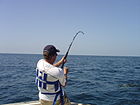Bottom fishing
Bottom fishing, called legering in the United Kingdom, is fishing the bottom of a body of water.
What is needed
A common rig for fishing on the bottom is a weight tied to the end of the line, and a hook about an inch up line from the weight. The method can be used both with hand lines and rod fishing. The weight can also be used to cast or throw the line to an appropriate distance. Bottom fishing can be done both from boats and from the land. Bottom fishing targets groundfish such as sucker fish, bream, catfish, and crappie. Specialized fishing rods called "donkas" are also commonly used for bottom fishing.
The objective for rigs used for bottom fishing is to take your bait to the bottom of the water and lure in the fish. The bait must appear appetizing to the fish. The most common rig used in bottom fishing is called a "fish finder rig". The next rig is called a "porgy rig" for the reason that it is effective on porgies, grunts, snapper, and any other schooling, medium-sized fish. A rig that is rarely used is called a "break-away rig". The final rig is called a "party boat rig" because you will see it on almost every party.[1]
Other meaning
In stock market terminology, bottom fishing can mean buying the cheapest investments (in terms of valuation ratios) available. Bottom fishing is value investing concentrated on the very cheapest companies. The term can be derogatory as it can imply a lack of attention to the quality of the investments selected.
In stock trading, bottom fishing can also describe the practice of driving the price of a security lower in order to trigger stop-loss orders, which will then commonly drive a security's price even lower, at which point the person or entity responsible for the triggering will then buy up those shares. As part of this phenomenon, a security's price will then often rise again quickly above the stop-loss order mark.
See also
Notes
- ^ Charlie. "Basic Bottom Fishing". Southern Chain Sport Fishing. Retrieved 10 July 2012.
References
- Keyes, Michael J (1992) Modern Bank Fishing: How to Leger - Bottom Fishing Techniques for Carp E a S Publications. ISBN 978-0-9634051-0-4



